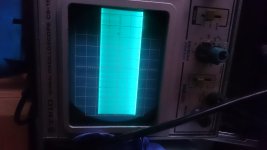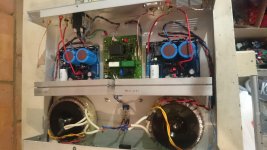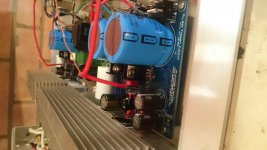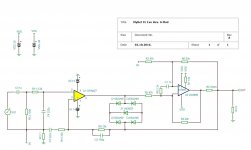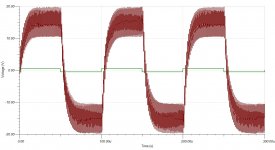Now that you have better speaker cables, try again... using RG400 coax cable. 😉
(but make sure to get a genuine one by some well known, good manufacturer from a trustworthy RF hardware shop. Stay away from the no-brand ones often found on eBay).
Inviato dal mio GT-I9100 utilizzando Tapatalk
Funny you mention that cos i was thinking of getting some Belden 1694A & Canare crimp RCA's from Canford Audio. I tried an interconnect made from DNM solid core, sounded much the same but added a low mains hum picked up from nearby power leads.
I next tried a 'twisted twin' type, silver coated copper with ptfe insulation. Apart from a very low hum in one channel probably due to a dodgy reused phono plug, they didn't seem to make any difference so i went back to the old ones made from Van Damme 'shotgun' interconnect cable. I have a 5 meter set somewhere made with Van Damme balanced mic cable from an old setup i might butcher at some point it i don't get the Belden co-ax to try.
The new speaker cables have made an improvement but changing interconnects seems not to, maybe cos they are only 50cm long. They do say well designed equipment is less affected by cable changes though 😀
Continuing the full diy theme, im using UBYTE-2 cables. Have quite a high capacitance but I opted for the evo version to compensate.
Just swapped back to some standard side by side cable to jog my memory and it doesn't sound as open or as detailed as the UBYTE-2.
Memory for audio is so short that some sort of switch box is probably a good idea for testing cables. The last two days have confirmed that i just don't seem to have the patience i used to have for making diy cables,i must be getting old

Took me a few weeks, but BOM ordered today! This project is getting expensive 😉 Some parts backordered, but mostly things like molex connectors... no worries.
Which transformers should I order if I'm making mono blocks? My current speakers are ~6 ohm minimum, but my next project is a 4 ohm design if that matters.
Which transformers should I order if I'm making mono blocks? My current speakers are ~6 ohm minimum, but my next project is a 4 ohm design if that matters.
Which transformers should I order if I'm making mono blocks? My current speakers are ~6 ohm minimum, but my next project is a 4 ohm design if that matters.
Then order transformers with 21-22V secondaries, 160VA minimum (for R-Cores 120VA also good).
Are nichicon fw 10000/50 good for c101 201?
i already have them ...
thanks
In general I recommend sticking to the BOM.
But since you have them, those FW will do in C101, C201.
If you feel something is wrong (like, for instance, a too relaxed bass) you can change them later.
Hello My_ref builders!
I'm trying to build my-ref v1.7 amp.
Can someone explain the correct placement of Wilma cap in c4 and c7.
I bought 4xc4 and 4xc7.
When I read the text on wilma, the micro marking on the side is different.
Is it correct that micro notch should always be on the left.
Shall circle in the marking on the PCB point to me and micro notch on Wilma to the left regardles of text side on Wilma.OR is it the text and the circle side should line up.
I'm trying to build my-ref v1.7 amp.
Can someone explain the correct placement of Wilma cap in c4 and c7.
I bought 4xc4 and 4xc7.
When I read the text on wilma, the micro marking on the side is different.
Is it correct that micro notch should always be on the left.
Shall circle in the marking on the PCB point to me and micro notch on Wilma to the left regardles of text side on Wilma.OR is it the text and the circle side should line up.
Just thought I'd share this as it might help others.
In the last week the amp has started to make some horrible sounds on start up which died down but you could still just hear buzzing on one channel.
Attached the scope, dummy load and shorted the inputs. The output on the bad channel (see pic) looked like it was oscillating at higher frequencies than my ancient scope could measure.
Seeing as this was a time induced fault I guessed was either a component failure or dry joint. I removed the board and started checking. Seems in my haste to install I didn't remove any of the flux from the soldier joints! Quick scribe around with a needle and then a scrub with solvent and brush it was all removed.
Assembled and checked again, no more noise!
Also attached a couple of case pics too.
In the last week the amp has started to make some horrible sounds on start up which died down but you could still just hear buzzing on one channel.
Attached the scope, dummy load and shorted the inputs. The output on the bad channel (see pic) looked like it was oscillating at higher frequencies than my ancient scope could measure.
Seeing as this was a time induced fault I guessed was either a component failure or dry joint. I removed the board and started checking. Seems in my haste to install I didn't remove any of the flux from the soldier joints! Quick scribe around with a needle and then a scrub with solvent and brush it was all removed.
Assembled and checked again, no more noise!
Also attached a couple of case pics too.
Attachments
Bc108,
I have difficulties to beleive that the resin residuals can cause this kind of problem..
The missing shielding around the LM3886 instead can lead to exactly this kind of oscillation..
What do I mean: the relatively high impedances in the bridge around the LM3886 renders that zone very sensitive, and the chip's velocity, essentially out to the Mhz range in the small signal region makes it a good receiver.
The unshielded metals around it instead act as a very good antenne for pickup;
So, for stability of the circuit it is essential a low impedance direct connection between the board's low impedance ground plane and the heatsink of the LM3886 chip.
Why did I enter this lengthy tirade: because I've been looking closely, but notice zero low impedance connection in your setup..
For this purpose you had only the PE connected to the chassis, which is a joke, RF and shielding wise.. (this was not directed to You, but the numerous PE advocates, on this forum..)
Ciao, George
I have difficulties to beleive that the resin residuals can cause this kind of problem..
The missing shielding around the LM3886 instead can lead to exactly this kind of oscillation..
What do I mean: the relatively high impedances in the bridge around the LM3886 renders that zone very sensitive, and the chip's velocity, essentially out to the Mhz range in the small signal region makes it a good receiver.
The unshielded metals around it instead act as a very good antenne for pickup;
So, for stability of the circuit it is essential a low impedance direct connection between the board's low impedance ground plane and the heatsink of the LM3886 chip.
Why did I enter this lengthy tirade: because I've been looking closely, but notice zero low impedance connection in your setup..
For this purpose you had only the PE connected to the chassis, which is a joke, RF and shielding wise.. (this was not directed to You, but the numerous PE advocates, on this forum..)
Ciao, George
Hi George,
I agree, It's not my contention that thorough cleaning effects the operation of a project. It simply allows one to spot things like cold joints and solder/wire bridges. Those can be tiny and easily hidden on a dirty board. 😉
I agree, It's not my contention that thorough cleaning effects the operation of a project. It simply allows one to spot things like cold joints and solder/wire bridges. Those can be tiny and easily hidden on a dirty board. 😉
Last edited:
To be clear, I'm not questioning the practice of cleaning the boards after assembly - very good and necessary practice, indeed.
Only that I consider the scope shot of bc108 a major fault, I doubt it could be the result of resin remnants, and I feel a bit of investigation is needed to clear up the situation..
And I think to have seen a clue in the photo of bc108's assembly..
Ciao, George
Only that I consider the scope shot of bc108 a major fault, I doubt it could be the result of resin remnants, and I feel a bit of investigation is needed to clear up the situation..
And I think to have seen a clue in the photo of bc108's assembly..
Ciao, George
Mouser-UPS-Norway-me
Hello everyone!
I bought 4 PCB V1.7 from Dario.The PCB was nice.Thanks to You!🙂
I followed the advice of Dario and bought parts from Mouser.
I used Mouser BOM on standard parts and HI-FI Collective UK
on "Best parts".
The parts from Mouser Electronics was 208.93 USD and shipping to Norway was free.
UPS delivered parts to my door in Norway and I was happy.
I started to solder party on to PCB immediately.
Then a week later i got a shock!😱
UPS sendt me a huge bill for 1765 NOK - 217USD for sending the package to me.
437 NOK-54 USD was VAT to Norway (ok I expected it)
158 NOK-20 USD was for disbursements commission?
but the big shock was that UPS would take 1170 NOK-144 USD to
declare goods over 5 product lines as they call it.
I've never heard of this practice before.
I feel that Mouser and UPS have deceived me with this hidden fee.
When I contakted Mouser and UPS they blame each other.
Mouser say it was me who chose UPS, but UPS was the default and
the other companies have the same price according to Mouser.
Number of small parts that was cleared was UPS's reason for the high price.
Are there others who have experienced this from Mouser and UPS?
I discourage others outside US to order parts from Mouser before
this with cost of custom processing and UPS is fixed.
This practice contributes to destroying the DIY hobby.
Hope Mouser and UPS can do something about this!
PS: anyone who can tell me right mounting Wilma cap.Text on PCBs
not the same way, onely a smal cirkel.Is Wilma directional?
Regards Ronny
Norway
Hello everyone!
I bought 4 PCB V1.7 from Dario.The PCB was nice.Thanks to You!🙂
I followed the advice of Dario and bought parts from Mouser.
I used Mouser BOM on standard parts and HI-FI Collective UK
on "Best parts".
The parts from Mouser Electronics was 208.93 USD and shipping to Norway was free.
UPS delivered parts to my door in Norway and I was happy.
I started to solder party on to PCB immediately.
Then a week later i got a shock!😱
UPS sendt me a huge bill for 1765 NOK - 217USD for sending the package to me.
437 NOK-54 USD was VAT to Norway (ok I expected it)
158 NOK-20 USD was for disbursements commission?
but the big shock was that UPS would take 1170 NOK-144 USD to
declare goods over 5 product lines as they call it.
I've never heard of this practice before.
I feel that Mouser and UPS have deceived me with this hidden fee.
When I contakted Mouser and UPS they blame each other.
Mouser say it was me who chose UPS, but UPS was the default and
the other companies have the same price according to Mouser.
Number of small parts that was cleared was UPS's reason for the high price.
Are there others who have experienced this from Mouser and UPS?
I discourage others outside US to order parts from Mouser before
this with cost of custom processing and UPS is fixed.
This practice contributes to destroying the DIY hobby.
Hope Mouser and UPS can do something about this!
PS: anyone who can tell me right mounting Wilma cap.Text on PCBs
not the same way, onely a smal cirkel.Is Wilma directional?
Regards Ronny
Norway
..... a bit of investigation is needed to clear up the situation..
And I think to have seen a clue in the photo of bc108's assembly..
Ciao, George

Hoping Partsconnexion order shows up today. Everything else on hand and ready to make some smoke.
 😀
😀
Last edited:
Royal Mail-Posten NO-me
My orders from Hi-FI Collective UK got stuck in customs in Norway and then
Posten sent the package back to UK.Someting was wrong with the paperwork.
I am a bit unlucky with these shipping companies.😕
Hope not Royal Mail UK and Posten NO gives me a big bill as UPS did.
I have not ordered toridal transformers and cabinet yet.
I look forward to that purchase!!
Shipment of these parts is very high.
Regret a bit that I started building this amps, but I can not stop now.
Hope the sound is worth it.I think it is.
My orders from Hi-FI Collective UK got stuck in customs in Norway and then
Posten sent the package back to UK.Someting was wrong with the paperwork.
I am a bit unlucky with these shipping companies.😕
Hope not Royal Mail UK and Posten NO gives me a big bill as UPS did.

I have not ordered toridal transformers and cabinet yet.
I look forward to that purchase!!
Shipment of these parts is very high.
Regret a bit that I started building this amps, but I can not stop now.
Hope the sound is worth it.I think it is.
Hi George,
I tried to reproduce your simulation results of MyRef with different opamps, but without success. I keep getting oscillations on the output. What am I doing wrong? Are the component values right? Or something is missing?
Here are the circuit and the results.
Dejan
I tried to reproduce your simulation results of MyRef with different opamps, but without success. I keep getting oscillations on the output. What am I doing wrong? Are the component values right? Or something is missing?
Here are the circuit and the results.
Dejan
Attachments
Dear Dejan,
As far as I see, you have done everything as it should be.
The same schematic does oscillate much less for me..
The only difference that we have is that for me, the lm3886 macro did not work, gave a pin mismatch error - so I stepped over this problem by choosing the Lm4780 macro, which, in theory, should be the same circuit, but a different macro..
Then, in reality, I have observed a slight oscillation, and as told, had to decrease the Cf value from 150pF to 100pF to get it stable.
How did you render the lm3886 macro functional? I would be much interested, because if it's more 'stringent' than the 4780 macro that would be a great help..
Anyway, since the last time I did a bit more testing. I did implement in an again another MyEvo amp the OPA1688, and have been listening to it.
Had also stabilized the LME49990 in an FE modul, and had made more test. It is quite clearly different from the lm318. Still has to listen to it. What i do not like so much is the amount of efforts needed to reach stability. Not so easy-going like with the Fet opamps.
I have just received some AD797 and 4898-1 to try to stabilize...
So, if can exchange models, I would try the lm3886.. and we could go on and get stable your circuit with that model, too.
Even if in real life it IS stable, in ~agreement with my actual model..
Ciao, George
As far as I see, you have done everything as it should be.
The same schematic does oscillate much less for me..
The only difference that we have is that for me, the lm3886 macro did not work, gave a pin mismatch error - so I stepped over this problem by choosing the Lm4780 macro, which, in theory, should be the same circuit, but a different macro..
Then, in reality, I have observed a slight oscillation, and as told, had to decrease the Cf value from 150pF to 100pF to get it stable.
How did you render the lm3886 macro functional? I would be much interested, because if it's more 'stringent' than the 4780 macro that would be a great help..
Anyway, since the last time I did a bit more testing. I did implement in an again another MyEvo amp the OPA1688, and have been listening to it.
Had also stabilized the LME49990 in an FE modul, and had made more test. It is quite clearly different from the lm318. Still has to listen to it. What i do not like so much is the amount of efforts needed to reach stability. Not so easy-going like with the Fet opamps.
I have just received some AD797 and 4898-1 to try to stabilize...
So, if can exchange models, I would try the lm3886.. and we could go on and get stable your circuit with that model, too.
Even if in real life it IS stable, in ~agreement with my actual model..
Ciao, George
The other day I completed upgrades 1-6 per Dario's numbering and put about 12hrs on the system.
This involved replacing C9 KZ with Cerafine and replacing RN55 at R7, R12 with Z-foils. All the others upgrades I already had in place. C32 is still in the original orientation.
The overall build is shown in post #2405. It's now the current BOM but with PTF6 in two places and R11 still KOA.
The sound is good and the timbre is nice. But I find the bass a bit boomy and heavy-handed. I changed my room and setup a bit, so this is not an A-B comparison.
Would replacing R101, R201 and R11 with RN55 type help my situation?
What are the sonic differences with the My_Evo Rev. A compensation? Would that take me in the right direction?
Are ebay Cerafines from asia a safe bet?
BK
Today:
- Replaced R101, R201, R11 with RN55 (had PTF6 and KOA)
- Replaced C1, C2 with Nichicon 50V PW (had 63V)
- Converted to Evo (remove 2 things, change 1)
Now FULLY in line with current BOM and upgraded with all the "audiophile" parts for grins.
Sounding really good with nice authority. Still seems tilted to the low frequencies, but I will run for a few weeks and see where I end up.
BK
- Home
- Amplifiers
- Chip Amps
- My_Ref Fremen Edition - Build thread and tutorial
